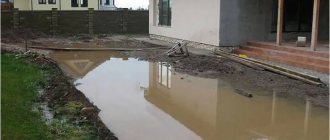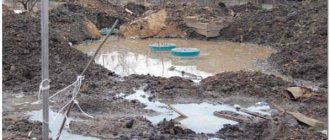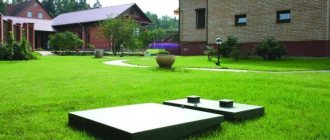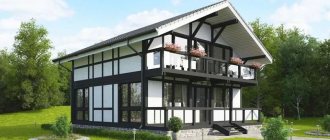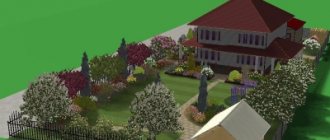This turned out to be not so easy, because there are many nuances in choosing land that the buyer usually is not even aware of.
In total, we and our clients inspected about 10 plots of land. Many of them are similar to each other, so for review they offered five options, using an example of which we will talk about their main “pros” and “cons”.
Close proximity is not good
Many of those who live on the land do not build houses according to building codes, which makes life difficult for new neighbors:
When we drove around the plots, Igor noticed that some houses and garages were located at the border of the plot at a distance of less than two or three meters, or even closer. That is, for fire safety purposes, we will have to build the house away from the neighboring house
“But if the plot of land is small and narrow, then we will have to look through each other’s windows. It's not entirely pleasant.
Without water and light
If you are looking for a good plot with a central water supply, be sure to check the prospects for connecting the water, Igor advises:
— Many sellers talk about the availability of water supply on the site. There is a well, the pipe is connected in some areas, but there is no water in the system and it is not known when it will be, since DNP has a debt to the installation company, or they need to install a multimillion-dollar pumping station. It is impossible to raise money on the network, because the owners do not appear, and some plots are put up for sale.
Location
When choosing a plot of land, everything is important, even the presence of a nearby roadway and dust on the road. Clients were attracted to a site adjacent to an unpaved road with heavy traffic, but after just five minutes of being there, their shoes were covered in a thick layer of dust. “What is the point of living on earth and breathing not fresh air, but dust?” - they asked themselves.
“At the same time, in winter or spring we would not have noticed this important detail. “We are also confused by the corner plot - any passerby can look into our yard and evaluate the property. This is a big risk.
Igor personally toured all ten sites together with his client family:
— When purchasing, we help our customers see all the pitfalls of certain plots and choose the most suitable one for their future home
It’s the same this time – we found a time convenient for the customers and went together to look at the sites. Before the search began, we discussed the project and adapted it to the needs of future residents, as well as to our climate. As a result, we visited a variety of sites. It took a few days, but it was worth it.
SNT or village?
It is better to choose a site in a village. Moreover, the village should be small, not located on a busy road, but not on the outskirts. Modern SNT with hundreds of plots are, as a rule, anthills, with plots of 6-8 acres, when you leave the house you run into a fence. There is nowhere to look out the window - either the fence or the neighbor’s house. The plots in the villages are large and you will not feel like you are in an aquarium or in a cage. In addition, you can register in the village without any problems, if necessary. There are no dues in the village. Electricity rates are generally lower. Roads are cleaned for free.
Cottage villages. This is something between SNT and a village. There are contributions, even, as a rule, higher than in SNT, tariffs are also higher, but in most cases these are individual housing constructions, you can register.
Nuances
There are some aspects that all homeowners should consider:
- Home ownership presupposes the presence of one address and inventory number. Therefore, it is often mistakenly viewed as a single entity. But unity is only functional. It provides convenience during accounting and technical work.
- It follows from this that real estate located in a household may have different owners, and therefore a different legal regime.
- It must be borne in mind that “ownership of a home” is not formalized, since such a concept does not exist. It is allowed to register the right to a house or auxiliary buildings.
- It often happens that the land and the house belong to different people. This usually happens if the land has been leased by the owner for a long time.
Therefore, the owner of a home may not necessarily be the owner of all objects. A house or plot of land may be registered in his name. The owner has the right to dispose only of his part.
Location of a relatively large city and travel time.
You should not choose a site near a large city for environmental reasons. However, you should not consider a site too far from your place of permanent residence, otherwise you will spend too much time on the road and waste a lot of gasoline. It is better not to count the mileage to the site along the roads, since they have different speed limits, may have constant traffic jams, etc., but it is better to calculate the average travel time to the site. In my opinion, the optimal travel time in terms of the ratio (time costs/fuel costs/environmental friendliness of the territory) for large cities is approximately 1 hour 30 minutes - 1 hour 50 minutes.
Location inside the village.
Look at the village plan. The best option is when the plots are located in one line relative to the road passing through the village. When there are no second or third lines. This gives the following advantages: your own access to the territory behind the site (for example, a forest, meadow, field, pond, etc.), and there is no neighbor behind, but only on the sides. When planning a village in several lines relative to the main road, problems very often arise with access to areas located on the second, and even more so the third line. With SNT there are usually no these problems (This is a plus of SNT - there is, as a rule, a pre-planned area for plots, with roads along all lines), but problems arise with villages: there are almost never roads to the second and third lines. These roads are trampled and driven over by the owners of these plots themselves. In the off-season, you can only drive there by SUV. They are almost never cleaned in winter. Therefore, when purchasing a plot of land in a village consisting of several lines, be sure to pay attention to the possibility of access to the plot. If there are several streets in the village, it is advisable to choose the outer side of the outermost streets so that the site has an unoccupied territory behind it.
Corner plots. Advantages and disadvantages.
In principle, there is only one plus for a corner plot: there is no neighbor on one side, and if the plots are located in one line, then it turns out that there is only one neighbor, on one side. Disadvantages of a corner plot. Additional costs for fencing. If you buy a plot located between others, then the side fences, as a rule, have already been built either by the previous owner or by the neighbors. When buying a corner plot, you will have to build one side of the fence in any case. If a corner plot is located inside the village and borders an inter-yard driveway, there is a possibility of excess noise from passing cars and illegal entry into the plot not only from the front, but also from the side.
TOP 3 tips on how to choose the right corner apartment
- Inspect your living space in the autumn-winter period to check exactly how warm the apartment is. If housing is sold on the secondary market, look at the clothes of the owners - when they are warm, then the room is cool and assurances to the contrary are not true;
- Don't be afraid to touch the walls in a corner room with your hand to check how wet and cool they are. If the corner wall is colder than the others and damp, check the outer corners and make sure there are no signs of mold or condensation;
- And if suddenly the external or internal walls were insulated, then always ask with what material and for how long ago. When the owner approached the issue wisely, the work used high-quality hydro- and thermal insulation, which will reduce heat loss in winter.
You may also be interested in:
vote
Article rating
Regarding noise and silence.
As I already noted, you should not choose plots in large villages and gardening communities. Even if you have chosen a certain large village, try to choose a site as far as possible from the entrance to the village and not on the main roads. This will save you from a lot of cars passing by. Also try to choose villages that are no closer than 400-500 m from regional roads and no closer than 900-1000 m from major highways. This dramatically reduces the likelihood of listening to the noise of cars passing on these roads around the clock. It is also better if there is a forest or at least a forest belt between such a road and the village. It will delay harmful emissions and further reduce noise from cars. If there is a flat field between the road and the village, then to reduce the noise level, it is advisable to increase the above indicated distances by one and a half times.
Transport accessibility and infrastructure.
When trying to isolate yourself and isolate yourself from noise, you shouldn’t overdo it. Always consider the possibility of getting to the site and back by public transport. Who knows what could happen? You should not choose villages located very far away in forests and fields. Buses don't even come close to there. Always ask if you can walk to the bus stop. Open maps and see how far away the bus stop is. The optimal distance for walking is no more than 1.5 km. A maximum of 2 km is about half an hour on foot. Here again preference is given to villages. The percentage of villages served by regular routes is much greater than the percentage of SNT.
Also pay attention to the quality of the access road to the village (not to mention the road inside the village to the site itself). As a rule, such roads are rarely paved with asphalt. More often these are gravel or primers or concrete slabs. Driving long distances on such roads is still a pleasure. Have mercy on yourself and the car's suspension. Therefore, I repeat, you should not choose villages located very far from the main roads of the area. The likelihood that you will have to drive this distance along a dead road, and even a single-lane one, on which you can’t really pass an oncoming car, especially in winter, is very high! In my opinion, the optimal distance from the main road to the village should be about 1 kilometer. You can’t hear the road, and the suspension doesn’t suffer much, and you can walk to the stop, if there is one there.
If there is a railway nearby
If there is a railway track closer than 500 m, then this is rather a minus. You can hear the trains. However, if the station itself is located at a distance of 500 m to one and a half kilometers, which can be reached on foot, this is a big plus.
Shops and other infrastructure
Also be interested in walking distance and the presence of grocery stores in general. Not everywhere, especially in small villages (this is their minus, by the way), there is a store. Pay attention to this (especially in combination with transport accessibility) if you are considering the possibility, for example, of leaving your grandmother and children at your future dacha for a while.
There is no need to talk about walking distance to other social facilities. It is very rare to find villages with their own clinic, gardens and schools. These are rather large villages or urban settlements, in which it is inappropriate to consider purchasing a plot according to the given criteria.
Basic requirements of the Development Rules
Let's take a closer look at the basic requirements of the Development Rules. Compliance with them is desirable in order to avoid legal battles with neighbors in the future. And also so that your house / barn / bathhouse is not in danger of being moved or demolished.
Setback - construction standards
First of all, it is necessary to decide on what land plot the construction is planned. In individual construction, we are most often talking about zones of individual residential development. These areas are allocated for individual housing construction or private plots and are located within the boundaries of the settlement.
To comply with construction standards, they must be deviated from:
- at least one meter from the boundary of the site when constructing a one-story residential building;
- one and a half meters when building a two-story building;
- two meters during the construction of a three-story residential building. (Provided that the distance to the residential building located on the neighboring plot is at least 5 m).
On a note! It must be remembered that from the future residential building to the border of the neighboring plot, due to sanitary conditions, the distance must be at least 3 meters.
No law specifies exact standards for the distance between houses of any form of ownership. Therefore, we remind you that in order to choose the right location for your future home, it is better to consult with the local administration.
It is the administration that provides explanations and instructions about accepted and approved standards for individual construction in a particular city or town.
Laying the foundation in accordance with SNiP
Distance from the fence to the construction site of the house
It is also necessary to understand that a certain distance must be maintained between your house, outbuildings, the fence and the neighbor’s house.
Don't build too close or too close. For example, in order to correctly mark the foundation and begin building a house, you need to determine how many meters it is to the neighboring residential building. And find out what exactly this building is made of.
Based on these data, you can calculate the required distance from the fence to the house:
- between houses of 1st and 2nd degree of fire resistance (concrete, brick, foam concrete, sandstone) there should be from 6 meters;
- if at least one of the houses belongs to the 3rd degree of fire resistance (metal or concrete frame with fire-protected ceilings and walls), then the distance between them is 8 meters;
- in the case of constructing a wooden house or if there is one on a neighbor’s plot, the distance between them must be at least 15 meters. Such structures are very fire hazardous. Similar requirements for the location of baths. These are exactly the buildings that should not be placed close to anything, especially flammable ones.
Design in accordance with codes and regulations
Distances between objects
We emphasize that all calculations of distances between objects are made exclusively in a straight line. If the houses are not parallel to the street and opposite each other, then the clearance between them is not so significant.
When building a house on small plots, it is necessary to make an indentation deeper into or closer to the road. For what? So that your neighbor's building and yours are not on the same line. Such a deviation is quite acceptable. For private houses, fire safety standards are mandatory, and failure to comply with them entails certain liability.
It is always necessary to remember that buildings that are too close to each other are more likely to suffer from fires. Sufficient setbacks must be made to secure buildings. It is also necessary to remember that firefighters in the event of an emergency must have open access to the source of the fire.
Dangers of territory development.
I bought a plot of land overlooking a field, and a residential complex was built there.
Such cases are not uncommon! Especially in the nearest suburbs. When choosing a site, be wary of choosing villages near large fields, especially if they are located near cities. There is a high probability that sooner or later something will be built on this field. Okay, if it’s a cottage community or SNT, which is also unpleasant, but what if it’s a high-rise building or an industrial enterprise? In our country anything can happen. And agricultural land is very easily converted into land for development. Try to choose plots in villages that border not on a field, but on a forest, or on a large body of water on one side and a forest on the other. Forest lands and water protection zones are very strictly monitored, and it is very difficult to transfer them to another category. Ideally, find an area bordering a forest or pond and having its own access to it. It's convenient and beautiful.
In any case, try to find a recent general plan for the area, and if there is none, always look at the cadastral map. Very often you can see there that a beautiful empty field has already been demarcated into areas for SNT or KP. If you do not like such a future neighborhood, avoid purchasing such plots.
Regulatory subtleties
“Home ownership” is a term that includes the ownership of a plot, house, or buildings. Usually they are located outside the city. There may be several or one owner of a household.
The regulations state that home ownership is a residential building (part of it), a plot, as well as ancillary, service and service buildings. The main link in this case is that all buildings are functionally interconnected. They are located on the same site. Therefore, the term “home ownership” is a broader concept compared to a house.
Communications.
The most important communication in my opinion is electricity. It is better if the site is already connected to the network. Otherwise there will be connection difficulties. And if for villages these are only difficulties with registration and technical connection, and the connection is carried out according to the state program for 550 rubles, then in the case of SNT the amounts can be exorbitant. I heard about the price tag for connection at 150,000 rubles. I consider it inappropriate to connect gas, even if it runs along the site, at a connection price of 350 thousand rubles or more. For this amount you can heat with electricity for many years. You will be lucky if the site has summer, and even more so winter (there are such cases) water from the village water supply.
Relief and soils on the site.
Sites are available with a slight slope, with a medium slope and with a strong slope. There are no absolutely horizontal areas in nature. Such areas are only specially leveled.
It is better to choose areas with a slight slope, up to 3% (difference of 3 m per 100 m of length). Such areas are considered relatively flat.
You should not choose a completely horizontal area. In such an area in the spring, after the snow melts or after rains, water stands for a long time and has nowhere to go.
You should also not choose areas with a large slope. Such areas have more disadvantages than advantages. Areas with a slope of more than 20% are generally not suitable for construction
Disadvantages of a site with a large slope:
- · the choice of location of both the house itself and buildings is noticeably limited;
- · there are problems with watering, since water will remain in the soil for a short time
- · movement around the territory is complicated, especially in icy conditions
- It is difficult to organize sufficient space for games and entertainment
- · the need to combat landslides and soil erosion
- · steep slope is a source of increased danger for children
- · poor orientation of the slope of the site relative to the sun can lead to either excessive or insufficient illumination of the earth's surface
- · the movement of air masses along the slope can lead to drying out of the soil at the top and frosts at the bottom of the slope
- Landscaping of a site with a large slope requires increased costs
- Possible difficulties with access roads
- · Providing water can be difficult
- · probability of flooding by melt and rainwater from higher areas
Advantages of a site with a large slope:
- · you will get the plot at a lower price, and the increased costs of its arrangement can be partially offset by your own creative work
- · water drainage problems are easily solved: the yard area will be dry, it will be possible to arrange the basement floor of the house or a cellar
- · problems with groundwater on such lands are a rare occurrence
- · the slope of a hill always protects the house from wind from one direction, if the slope is global. And the site is located on a hillside
- · the cost of constructing the basement floor of a building is noticeably reduced, since the entire excess volume of land is easily used to partially level the terrain
- · the windows of the house, located high, offer a wide view
- · when placing the site on the south side of the slope, the insolation of the courtyard can be increased, on the contrary, if the site is located on the north side, solar activity will be weakened
- · an area located on an eastern or western slope will have average illumination
- · apparently the most important thing: using a huge list of landscape design techniques will allow you to obtain a natural, organic and unique design of the site
Soils on the site
Before purchasing a plot, it is also necessary to analyze the type of soil on it and approximately determine the depth of groundwater.
Types of soil
When viewing a site on the ground, you need to determine the type of soil. The soil can be light, medium or heavy. In order to determine the mechanical composition of the soil, take a soil sample (no more than 1 teaspoon), moisten it with water and roll it into a ball. If the ball does not work out, it means that the soil is sandy. If you succeed, then roll it into a cord. Does not roll out - the soil is sandy loam. If you get a cord, try to roll it into a ring. The ring does not work out - the soil is light loamy. If the ring turns out, but cracks and breaks badly, the soil is medium loamy; the ring is slightly cracking - the soil is heavy loam. Finally, if the ring takes any shape, the soil is clayey. You can also determine the type of soil by rubbing a handful of soil between your fingers. The table below will help you determine the soil characteristics.
Soil type
| Soil Features | Application in horticulture | |
| The soil is heavy, clayey | After rubbing, it gets very dirty on your fingers; when wet, it can be easily sculpted (you can sculpt various shapes from it) | Rich in nutrients and moisture. Unfortunately, it is very dense, does not allow air to pass through well and is difficult to cultivate. It is not recommended to use such soil in its pure form. |
| The soil is average, sandy-clayey. | After rubbing, you feel the presence of sand, your fingers become slightly dirty; when wet, you can make thick rolls from it that are easy to tear. | It absorbs and retains water well, is moderately loose and breathable, and warms up well. It is the most fertile. |
| The soil is light and sandy. | It crumbles easily, is not plastic, does not contaminate your fingers, and cannot be sculpted even when wet. | The main advantage is good air throughput. Water does not stay in it, resulting in rapid drying. Nutrients are easily washed away. Such soil can be improved by adding organic fertilizers. |
The approximate level of soil fertility can be determined by the wild plants growing. Fertile soil is the “habitat” of common grass, nettle, creeping buttercup, plantain, dandelion ... If among these plants the main proportion is plantain, then you are dealing with dry soil. The predominance of buttercup is a feature of moist soil. The soils on which nettle grows are loose, rich in organic matter.
Daisies, odorless daisies and white clover grow in barren and poor soils. The appearance of these plants indicates that it is imperative to regularly fertilize with complex fertilizers. If there is a large amount of woodlice, nettle, field mustard, small-flowered galinzoga or minuartia , then this indicates that there is a lot of nitrogen in the soil. When fertilizing, then you should use only manure that lacks this element. The appearance of horsetail, coltsfoot or creeping buttercup indicates that the soil is wet, heavy and acidic. In this case, it is recommended to loosen the soil and also mix it with sand.
If you notice dandelions and buttercups , it means that the soil is heavy and clayey, too wet. Most often, such soil is found in areas that have not been processed for a long time. This soil is poor in oxygen.
Ground water level.
You should not choose a site with a high groundwater level. This threatens the area with waterlogging in spring and autumn.
First of all, the depth of groundwater depends on the topography of your site, as well as on the presence or absence of rivers and streams, that is, water bodies nearby. Where the soil is swampy or in the lowest areas, groundwater is almost always found on the surface of the soil, often rising more than half a meter from the surface and rarely falling below one meter.
The best time to determine the groundwater level at a site is early spring, usually at this time groundwater reaches its maximum.
You can determine the groundwater level visually, just go to a nearby well and look inside; if it’s dry, then the groundwater is located deep and there is no danger, you can plant, but if the well is full of water, then this should alert you. Typically, water in a well can come from some underground source. The distance from the water surface to the soil surface can be determined by lowering a tape measure or string there. On the Internet you can find a map of groundwater depths, as well as a map of well depths. It is believed that the deeper the well, the purer the water.
Another option for determining the level of groundwater is based on the plants that grow in a given area. Let's say that an area looks completely dry, but if it is covered with lush vegetation that loves moisture and it grows wildly and luxuriantly, it means that, most likely, groundwater is lurking somewhere close to the surface.
the nettles , sedges , hemlocks , reeds , foxgloves, horsetails, reeds, cattails, horse sorrel, meadowsweet, or meadowsweet and similar plants growing in the area should alert you In this case, the maximum depth of the groundwater level will be two meters (but this is in the best case).
Willow, birch, maple, alder and weeping willow leaning in one direction are a sign of the presence of a water vein nearby. Single oaks tend to grow at the intersection of water veins.
If the plant community is dominated by forest reed and meadowsweet (meadowsweet) gray and black alder are also present in them , then this indicates that the water lies at a depth of up to 3 m.
wormwood or licorice grows in the area , then you can breathe easy: most likely, the groundwater is three meters away, and in this area you can plant anything you want.
You can notice the close standing of groundwater by the color of the plants growing in a given area; there they will be as juicy and bright green as possible, without the slightest hint of a lack of moisture in the soil.
Pay attention to the area in the evening, if there is fog , then the groundwater is as close to the surface as possible, and two meters in this case will be the limit. Also, in areas with close groundwater, dew .
If the groundwater level in your area has exceeded 1 meter from the surface or part of the soil is simply swampy, then you will have to build a structure to drain excess moisture - a drainage pond. The likelihood of waterlogging in an area can be indirectly determined by the abundance of reservoirs with high water levels in the area.
Residential building in SNT: how to calculate the distance
When planning the construction of a residential building, you should maintain a distance not only to the fence of the neighboring site, but also to the driveways and streets adjacent to the site. When designing, SNiP 30-02-97 or its updated version - SP 53.13330.2011 is considered as a basic regulatory document. The documents regulate the procedure for planning and developing the territories of horticultural and gardening associations.
Violation of the norms specified in the document leads to the emergence of territorial claims. In order to avoid claims related to improper construction of the building, individuals - owners of the site - are strongly recommended to read paragraph 6, which is fully dedicated to about the planning and development of sites. And first of all, you need to know at what distance from the fence to build a house and what is the distance to the red lines of driveways and streets.
Measurement procedure
3a The reference point is taken from the base of the house. If there is no base, measurements begin from the wall. If the project provides for the presence of elements such as a porch, bay window, canopy, etc., they are sometimes taken into account when calculating the distance, and sometimes not. In order to correctly maintain the distance between the house and the fence, the following rules apply:
- if a structural element protrudes from the wall by less than 0.5 m, it is not taken into account and the plane of the wall is taken as the reference point;
- If the protruding part is wider than 0.5 m, the distance is calculated from it.
This point needs to be remembered, because very often when measuring acceptable limits, they forget about the porch, and especially about the balconies on the second floor. Principled neighbors can create problems for the owner of such a house.
Important: the dimensions of the second floor balcony, roof overhang, canopy are taken as the size of their projection onto the ground.
Proximity to neighboring residential building: fire requirements
When designing, not only the fencing of the site is taken into account, but also construction objects located on other sites. The minimum distance between residential buildings, including grouped and blocked ones, is not a constant value and depends on the materials of the load-bearing walls.
The most obvious way to show the distance between houses when building a private house is in a table version:
The indicated figures are valid not only for plots with common boundaries, but also for land plots located on different sides of the road.
For reference: there are no documents regulating the fire distance between buildings on the same site.
Ideal site.
Summarizing the above, I see the ideal site as follows:
Located in a village located about a kilometer from the district road, on which there is a bus stop to the district center, from where, in case of emergency, you can take the train home; surrounded by forests or forest belts.
It takes about an hour and a half or a little more to get to the site by car.
The site is located in a community that has only one street and only one line on each side of the street. Or located on the outer sides of the outer streets, if there are several of them.
The plot has its own access to a forest, field or pond from the rear.
The size of the plot is 12-15 acres.
Electricity has been supplied to the site and a meter has been installed.
The site has a slight slope not to the north.
The site has medium loamy or sandy loam soils with a low groundwater level.
Rights
Ownership is a person's right to property. This involves ownership, use, and disposal of real estate. Home ownership is also property. Therefore, the owner can perform various actions with him, but they should not contradict the law.
Household ownership includes a residential building, which must be suitable for permanent residence. This facility is being built in accordance with the requirements of the law. A site is a certain area of land on which buildings can be located. The necessary communications must be available on the property's territory. Ownership rights cease upon sale, gift or other legal transactions.



